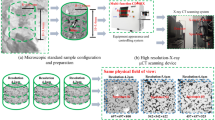Abstract
In this article, porous media theories are referred to as mixture theories extended by the well-known concept of volume fractions. This approach implies the diverse field functions of both the porous solid matrix and the pore fluid to be represented by average functions of the macroscale.
The present investigations are based on a binary model of incompressible constituents, solid skeleton, and pore liquid, where, in the constitutive range, use is made of the second-grade character of general heterogeneous media. Within the framework of geometrically finite theories, the paper offers a set of constitutive equations for the solid matrix, the viscous pore liquid and the different interactions between the constituents. The constitutive model applies to saturated as well as to empty solid materials, taking into account the physical nonlinearities based on elasto-plastic solid deformations. In particular, the constitutive model concentrates on granular materials like soil or concrete, where the elastic deformations are usually small and the plastic range is governed by kinematically hardening properties.
Similar content being viewed by others
References
Bachmat, Y. and Bear, J., 1986, Macroscopic modelling of transport phenomena in porous media. 1: The continuum approach,Transport in Porous Media 1, 213–240.
de Boer, R., 1988, On plastic deformation of soils,Int. J. Plasticity 4, 371–391.
de Boer, R. and Brauns, W., 1990, Kinematic hardening of granular materials,Ing. Archiv 60, 463–480.
de Boer, R. and Dresenkamp, H.-T., 1989, Constitutive equations for concrete in failure state,ASCE: J. Engrg. Mech. 115, 1591–1608.
de Boer, R. and Ehlers, W., 1986, On the problem of fluid- and gas-filled elastoplastic solids,Int. J. Solids Structures 22, 1231–1242.
de Boer, R. and Ehlers, W., 1990a, The development of the concept of effective stresses,Acta. Mech. 83, 77–92.
de Boer, R. and Ehlers, W., 1990b, Uplift, friction and capillarity: Three fundamental effects for liquid-saturated porous solids,Int. J. Solids Structures 26, 43–57.
de Boer, R. and Kowalski, S. J., 1983, A plasticity theory for fluid-saturated porous solids,Int. J. Engng. Sci. 21, 1343–1357.
Bowen, R. M., 1976, Theory of mixtures, in C. Eringen (ed.),Continuum Physics, Vol. III, Academic Press, New York, pp. 1–127.
Bowen, R. M., 1980, Incompressible porous media models by use of the theory of mixtures,Int. J. Engng. Sci. 18, 1129–1148.
Bowen, R. M., 1982, Compressible porous media models by use of the theory of mixtures,Int. J. Engng. Sci. 20, 697–735.
Cross, J. J., 1973, Mixtures of fluids and isotropic solids,Arch. Mech. 25, 1025–1039.
Ehlers, W., 1989a, On thermodynamics of elasto-plastic porous media,Arch. Mech. 41, 73–93.
Ehlers, W., 1989b, PORöSE MEDIEN — ein kontinuumsmechanisches Modell auf der Basis der Mischungstheorie,Forschungsberichte aus dem Fachbereich Bauwesen der UniversitÄt Essen, Vol. 47, Essen.
Ehlers, W. and Plischka, J., 1991, Die Durchschnittsbildungstheorie und ihre Bedeutung in der phÄnomenologischen Kontinuumsmechanik,ZAMM 71, T327-T330.
Hassanizadeh, M. and Grey, W. G., 1979a, General conservation equations for multi-phase systems: 1. Averaging procedure,Adv. Water Resour. 2, 131–144.
Hassanizadeh, M. and Gray, W. G., 1979b, General conservation equations for multi-phase systems: 2. Mass, momenta, energy and entropy equations,Adv. Water Resour. 2, 191–203.
Heinrich, G. and Desoyer, K., 1955, Hydromechanische Grundlagen für die Behandlung von stationÄren und instationÄren Grundwasserströmungen,Ing. Archiv. 23, 73–84.
Kojić, M. and Cheatham, J. B., 1974, Theory of plasticity of porous media with fluid flow,AIME: Soc. Petr. Eng. J. 14, 263–270.
Lade, P. V., 1977, Elasto-plastic stress-strain theory for cohesionless soil with curved yield surfaces,Int. J. Solids Structures 13, 1019–1035.
Müller, I., 1968, A thermodynamic theory of mixtures of fluids,Arch. Rational. Mech. Anal. 28, 1–39.
Nigmatulin, R. I., 1979, Spatial averaging in the mechanics of heterogeneous and dispersed systems,Int. J. Multiphase Flow 5, 353–385.
Phillips, A., 1974, The foundations of thermoplasticity — experiments and theory, in J. L. Zeman and F. Ziegler (eds),Topics in Applied Continuum Mechanics, Springer-Verlag, Vienna, pp. 1–21.
Prévost, J. H., 1981, Consolidation of anelastic porous media,ASCE: J. Eng. Mech. Div. 107, 169–186.
Simo, J. C. and Taylor, R. L., 1985, Consistent tangent operators for rate-independent elastoplasticity,Comput. Meth. Appl. Mech. Engrg. 48, 101–118.
Author information
Authors and Affiliations
Rights and permissions
About this article
Cite this article
Ehlers, W. An elastoplasticity model in porous media theories. Transp Porous Med 9, 49–59 (1992). https://doi.org/10.1007/BF01039625
Received:
Issue Date:
DOI: https://doi.org/10.1007/BF01039625



